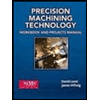Question 1 (a) The three planes of 'orthographic' projection of an object are presented in Figure 1.1 below. Draw by hand an isometric view of the object. The dimensions of your drawing are not important. -38- Side View Front View Top View Figure 1.1 (b) The isometric view of an object is presented in Figure 1.2 below. Draw by hand three planes of 'orthographic' projection (i.e., top, front, and side views). The dimensions of your drawing are not important.
Question 1 (a) The three planes of 'orthographic' projection of an object are presented in Figure 1.1 below. Draw by hand an isometric view of the object. The dimensions of your drawing are not important. -38- Side View Front View Top View Figure 1.1 (b) The isometric view of an object is presented in Figure 1.2 below. Draw by hand three planes of 'orthographic' projection (i.e., top, front, and side views). The dimensions of your drawing are not important.
Precision Machining Technology (MindTap Course List)
2nd Edition
ISBN:9781285444543
Author:Peter J. Hoffman, Eric S. Hopewell, Brian Janes
Publisher:Peter J. Hoffman, Eric S. Hopewell, Brian Janes
Chapter3: Job Planning, Benchwork, And Layout
Section3.1: Understanding Drawings
Problem 4RQ: The line type used to show edges of an object that can be seen in a particular view is called...
Related questions
Question
Please could I have the solutions for this question in a step-by-step form. Thank you very much.

Transcribed Image Text:Question 1
(a) The three planes of 'orthographic' projection of an object are presented in
Figure 1.1 below. Draw by hand an isometric view of the object. The
dimensions of your drawing are not important.
-38-
-38-
Side View
Front View
Top View
Figure 1.1
(b) The isometric view of an object is presented in Figure 1.2 below. Draw by
hand three planes of 'orthographic' projection (i.e., top, front, and side views).
The dimensions of your drawing are not important.
Figure 1.2
-IT
Expert Solution
This question has been solved!
Explore an expertly crafted, step-by-step solution for a thorough understanding of key concepts.
Step by step
Solved in 2 steps with 2 images

Knowledge Booster
Learn more about
Need a deep-dive on the concept behind this application? Look no further. Learn more about this topic, mechanical-engineering and related others by exploring similar questions and additional content below.Recommended textbooks for you

Precision Machining Technology (MindTap Course Li…
Mechanical Engineering
ISBN:
9781285444543
Author:
Peter J. Hoffman, Eric S. Hopewell, Brian Janes
Publisher:
Cengage Learning

Precision Machining Technology (MindTap Course Li…
Mechanical Engineering
ISBN:
9781285444543
Author:
Peter J. Hoffman, Eric S. Hopewell, Brian Janes
Publisher:
Cengage Learning